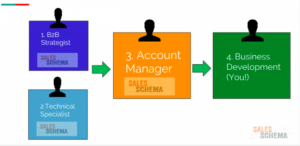Want to learn how to win your top ten dream clients in just a few easy steps? Then you’re in the wrong place. One of the biggest problems with most case studies and sales tactics is that they attempt to make hard problems seem easy to solve.
What nobody wants to admit is that convincing marketing leaders at mid-to-large companies to jump into bed with your agency is HARD. It takes time and effort, especially if going beyond referrals and your personal network is new for your agency. This is where we come in.
But going out to the big cold world to win business is a worthwhile mission, like joining the Navy Seals or landing first chair in The National Orchestra. And what’s the alternative?
If you want to grow your agency, or simply by choosier about your clients, you will have to develop a repeatable sales process to win over prospects who are problem-aware but not yet necessarily solution-aware.
By the end of this unconventional case study, the journey from cold to closed business will feel a lot less murky.
The agency’s situation
Our client is a San Francisco-based full-service branding and creative services firm specializing in naming, audience engagement, and video storytelling.
The agency’s target buyers include enterprise technology firms, e-commerce, manufacturing, and B2B technology, with a focus on companies going through mergers and acquisitions.
Common to most of our clients, this agency experienced an over-reliance on referrals, overwhelm and lack of bandwidth, and not enough opportunities to sustain their growth goals.
The less-than-tiny text: our client’s strengths
Here’s what our client had going for them:
Experience.
Decades in business, 40+ marquee clients (mostly Fortune 500) prominently listed on their homepage.
Positioning.
Relatively clear positioning.
Committed to growth.
They established clear falsifiable goals and had a strong resolve to achieve them.
Right mindset.
Our client understood they had permission to build relationships with companies they knew they could help, and they understood that if they did not get their first, their competitors would.
“But I don’t have a massive logo wall!”
The good news is that most of our clients are far less accomplished than the one in this case study. And you can signal trust, security, and specialization in different ways. For one, specialize. On your site, make it easy for prospects to put you in a box.
Counterintuitive, right? Don’t you want to be known as agnostic freethinkers? Perhaps as individuals, but when your prospect is juggling dozens of vendors and getting pelted by hundreds of pitches every month, them understanding you quickly is important.
Phase 1: Targeting and Cluster-Based Specialization.
Specialization is often the cornerstone of our effectiveness for our clients. We started by developing a distinct few Clusters, or small buyer groups who share similar problems and characteristics. These Clusters are typically 100-2000 buyers.
It’s all about depth over breadth, while ensuring enough prospect volume to produce a meaningful volume of opportunities. These Clusters are not necessarily in different industries, as they are typically subsets of the same area. If there is industry separation, it helps if the Clusters have what Drew calls, “connective tissue”, or similar characteristics.
Why data doesn’t matter.
Okay, I went clickbait-y with this header – sometimes data can be valuable, but in your hectic agency, the scarce commodity is attention, and your success hinges on your ability to implement a system that harnesses it amongst your busy buyers.
The data is simply a raw material – like drywall or paint, and it’s getting cheaper every day. Still, one of the most common questions we get is, “How do you source your data?”
In this case study, the data source is LinkedIn, the world’s largest business networking platform. If you’re a drug dealer, you might not update your LinkedIn profile, but pretty much everyone else does consistently. There are many B2B data purveyors who are simply scraping and repackaging LinkedIn.
In this case, we built out six Clusters on which to focus our campaigns, and here are a couple of examples:
- Midwest traditional e-commerce brand marketing leaders. (866 prospects).
- Mergers and acquisition advisors (1,892 prospects).
When you start searching for your buyers, the keywords and other parameters you use tend to be more on-point when you start at the account-level and next drill down to the lead level. LinkedIn’s Sales Navigator makes this process straightforward.
Phase 2: The outreach calendar.
Next, we crafted a 12-month Outreach calendar and mapped our Cluster-based campaigns to specific months.
This is important because buying cycles matter – for example, reaching out to travel and tourism in the summer is often a bad idea because they’re in execution mode, the same goes for e-commerce over the holidays.
Also, the calendar helps our clients understand the long-term nurture process that prospects must go through so they can get to the point of being qualified to conduct a business conversation.
Phase 3: The Copy.
At the end of the day, it’s all about the right words to the right people. The main qualities that made our copy convert were restraint, scarcity, and legibility. The last one is huge.
We crafted the copy across multiple channels, including LinkedIn, email, and phone. There are near-infinite creative ways to reach and convert your prospects to the calendar, so let’s start with what we knew NOT to do…
Avoiding the Weak Middle.
Our experience tells us that a well-targeted yet brief digital message, signaling (not overtly stating) authority and scarcity, is effective, and it’s the approach we typically start with, as we did here.
On the other end of the spectrum, sending prospects expensive, creative, and un-trash-able gifts can drive a high rate of opportunities. As will camping out in front of their office blasting 80’s dance hits on a boombox, like John Cusack in Say Anything (admittedly, that last one is riskier).
But you want to avoid the weak middle, and here are examples of what NOT to do.
- Untargeted mass email blast.
Puts the agency in the spam box – there are probably many examples sitting in yours right now. - Overwrought, cow-towing request…
“I researched your website, read your article, followed you around outside your office, and if you’re not too busy, please sir, can you spare five minutes?” - A portfolio-focused brag letter.
Signals that the agency has enough time and money to launch a mail campaign, but not enough to be creative or dynamic, or care about the client’s problems.
The anatomy of a high-converting message.
The aesthetics and the physical shape of the message trigger a green light from the reader (“yes, I’ll read this”), or a redlight (“no, I’ll trash or spam box this one”). Busy readers make snap judgments.
Once your prospect reads it, if you come in with the right tone, legibility, social proof, and ease of response (a big “if” I know), you will convert them. There are exceptions, but in our world, brevity tends to win.
“Ok, so what copy did you use?”
Without giving away the farm, and since templating doesn’t work anyway, let’s get into it.
Again, the main element that makes this work is effective targeting through Cluster-Based Specialization, and in some instances we ran campaigns to fewer than 50 prospects.
Here’s what we did in this case:
1. LinkedIn pre-nurturing.
-Put a face to a name.
-What we do and who we do it for.
-Social proof (ie. name drops/recent wins)
-Asking for nothing.
2. 3-5 days later: Email drip campaign.
-Brief
-Ask a question to reveal a problem.
-Elaborate on value prop.
-Keep it legible and easy to understand.
-Call-to-action, typically a call.
-Tone: casual, reads like it was typed out on a phone, important: matches personality of sender.
3.One-to-one nurturing: see Phase 4…
Phase 4: Human-Centric Nurturing.
One of the biggest mistakes we see is when agencies spend too much time on tactics and not enough nailing down who’s doing what.
As a result, those in client service roles are conscripted to do internal sales and marketing as a hobby, and they fiddle with CRMs and data for weeks, and as soon as their clients need something, the train falls off the tracks.
We provide the platonic ideal of an agency sales team to our clients because teeing-up opportunities requires consistency.
The team is three roles on our side and one on our client’s side:

Team Breakdown:
- B2B Strategist.
Writes and optimizes copy and targeting, every 30 days (once we have statistically-significant data).
Qualities: creative, deep market knowledge, curious. - Technical specialist:
Ensure deliverability, data hygiene, and campaign execution.
Qualities: Attention to detail, technical prowess, geek. - Account Manager (SDR/BDR).
Nurtures prospects, handles initial objections, converts prospects to the calendar. Qualities: professional, persistent, people person, basic sales skills. - Business Development (our clients).
Closes deals, optimizes sales processes, maintains relationships. Qualities: creative, persistent, growth-minded, curious.
Converting from “interested” to showing up.
Scheduling is a process that’s often taken for granted, but it’s pivotal to success, and it requires human nurturing via one-to-one phone and digital communications, sometimes through as many as ten or twenty touchpoints.
Our Account Managers (Role 3 above) are extremely good and professionally and persistently herding cats.
Phase 4: The Sales Process.
For referral-driven agencies, there’s rarely a defined sales process, and often the Apocalypse Now conversation plays out…

Developing your sales process happens best in the trenches, and we’re able to help our clients get the reps they need by getting them ideal first dates with a steady flow of brand-side marketing leaders.
But per The Horror… above, often there is no process. The meeting ends, both parties wave goodbye, and that’s it. From there, the agency periodically wastes resources on proposals without proper qualifying, and occasionally follows up months later when they find time.
Our best agencies, on the other hand, are masters at answering the three big questions for their prospects: Why This? Why Us? Why Now? And they nurture their prospects at each stage of the buyer journey, sending the right case studies and other materials, not just portfolio links, to answer the big three questions.
Our best clients are extremely disciplined when it comes to qualifying for BANT (Budget Authority Need and Timeframe) before creating a presentation.
From there, they do all presentations live, to all decision-makers, via an in-person meeting or video conference, and they set the expectation for a decision following the presentation. If these boxes are not checked, the presentation does not happen.
Most importantly, our best clients make an immediate, low-risk no-brainer offer to get started. This might be a paid audit, small project, pilot program, or something similar.
Outcomes.
I hope you don’t mind me lazily screenshotting the results:

In addition to the immediate and long-term opportunities we generated, our client was able to enter new Clusters and double down on past wins to segue into previously untapped markets.
If you want to learn more about this case study and others, including plenty of nitty-gritty tactics, check out our latest video training.






